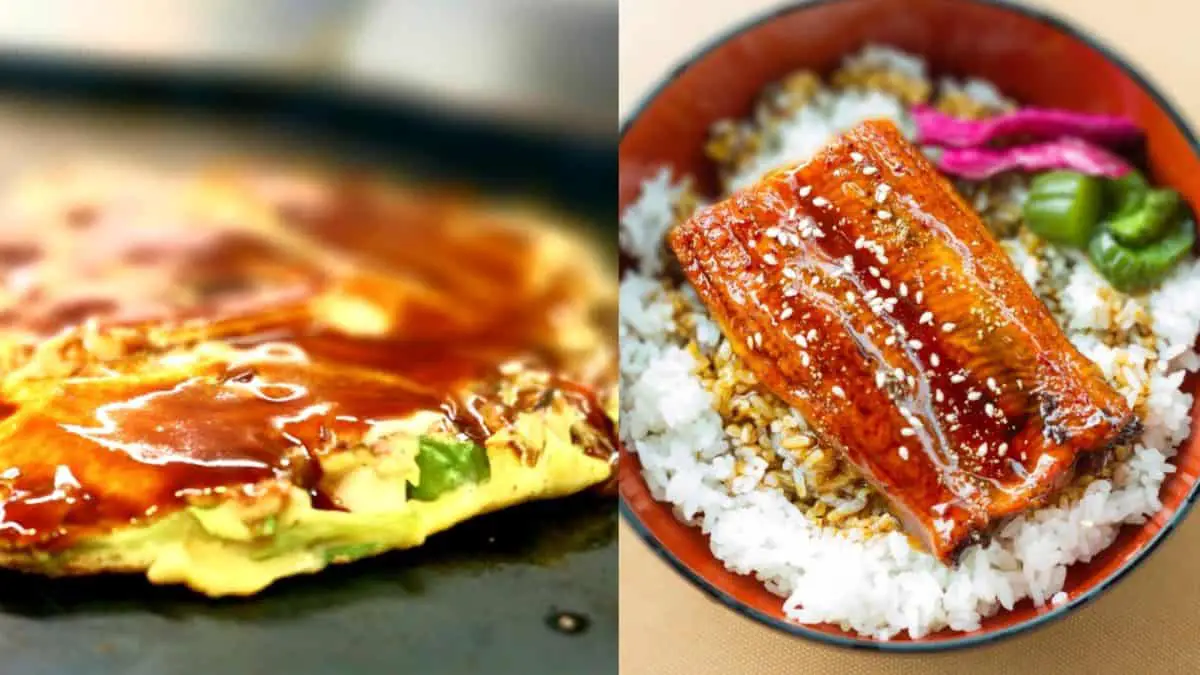Okonomiyaki VS Unagi (Nitsume) Eel Sauce: Differences & Uses
If you’re a fan of Japanese cuisine, you’ve probably had okonomiyaki and unagi before. But what’s the difference between these two sauces? And which one is best for your dish?
Okonomiyaki sauce is a red sweet sauce that uses Worcestershire as its main flavoring ingredient, used as a topping for okonomiyaki pancakes. Nitsume unagi eel sauce is a black sweet sauce that uses soy sauce, mirin, and sake as its main ingredients used to glaze fish.
In this post, I’ll explore the differences between okonomiyaki sauce and unagi sauce, and give you tips on how to use each sauce in your favorite Japanese recipes.


Check out our new cookbook
Bitemybun's family recipes with complete meal planner and recipe guide.
Try it out for free with Kindle Unlimited:
Read for freeIn this post we'll cover:
What is okonomiyaki sauce?
Okonomiyaki sauce is a thick, brown sauce that is typically made with fruit and vegetable extracts, Worcestershire sauce, and sugar.
It has a slightly sweet and savory flavor that pairs well with okonomiyaki, a Japanese pancake that is made with cabbage, egg, meat, seafood, and flour.
If you’d make it yourself, ketchup is often used to come close to the taste of all of the separate fruit and vegetable ingredients, of which tomatoes are a large one.
What is unagi sauce?
Unagi sauce is a syrupy, soy-based sauce that is used to top unagi or grilled eel, and it’s called Nitsume. Unagi is actually the eel itself.
It is sweet and savory, with a consistency that is similar to molasses. The main ingredients in unagi sauce are soy sauce, sugar, mirin (rice wine), and sake (rice wine).
While unagi sauce is traditionally used as a topping for grilled eel, it can also be used as a dipping sauce for tempura or as a glaze for roasted meats.
Okonomiyaki vs unagi sauce
The biggest difference is in the ingredients. Okonomiyaki sauce is made with fruit and vegetable extracts, Worcestershire sauce, and sugar, while unagi sauce is made with soy sauce, sugar, mirin, and sake.
They are both sweet, savory, and thick in consistency. However, okonomiyaki sauce is less sweet than unagi sauce and has a slightly smoky flavor due to the Worcestershire sauce.
Nitsume unagi eel sauce is primarily used to glaze a piece of fish before frying, to give it a nice shiny and caramelized exterior. Okonomiyaki sauce is used as a topping on pancakes after they’re cooked to provide extra flavor.
Because of the added soy sauce, nitsume eel sauce is also dark in color, while okonomiyaki sauce is reddish in color because of the ketchup (or tomatoes/ tomato paste) it’s made with.
Can you use okonomiyaki sauce on unagi?
Using okonomiyaki sauce on unagi will not taste the same as if you used nitsume eel sauce. It’s too smoky from the Worcestershire, and the lack of mirin and sake cause the ell to not get the same shine as it would from the nitsume.
It would just look really off with a reddish thick sauce smeared over it.
Unagi is so delicate, and there’s not much else going on in the dish besides the fresh eel and the nitsume sauce, so any differentiation in flavor from the sauce would throw the whole dish off.
Can you use unagi sauce on okonomiyaki?
You can use unagi sauce on okonomiyaki, it’s also sweet and has some of the same flavor profiles. It won’t be as smoky and you wouldn’t have the same effect of the square pattern with okonomiyaki sauce in one direction, and kewpie. in the other, but it could do as a substitute.
There’s already a lot going on in the okonomiyaki dish, so having a slightly different flavor profile could be ok.
Conclusion
So okonomiyaki and unagi nitsume eel sauce are really two different sauces, made with different ingredients, they look different and they are used differently.
Check out our new cookbook
Bitemybun's family recipes with complete meal planner and recipe guide.
Try it out for free with Kindle Unlimited:
Read for freeJoost Nusselder, the founder of Bite My Bun is a content marketer, dad and loves trying out new food with Japanese food at the heart of his passion, and together with his team he's been creating in-depth blog articles since 2016 to help loyal readers with recipes and cooking tips.
